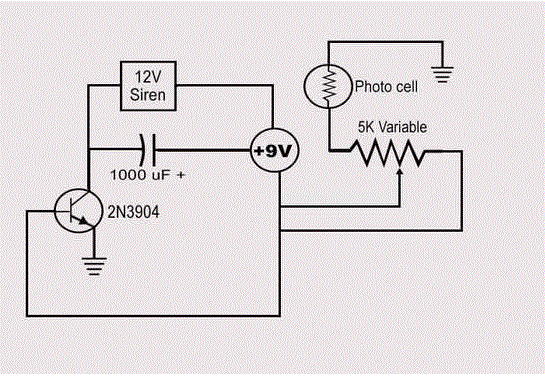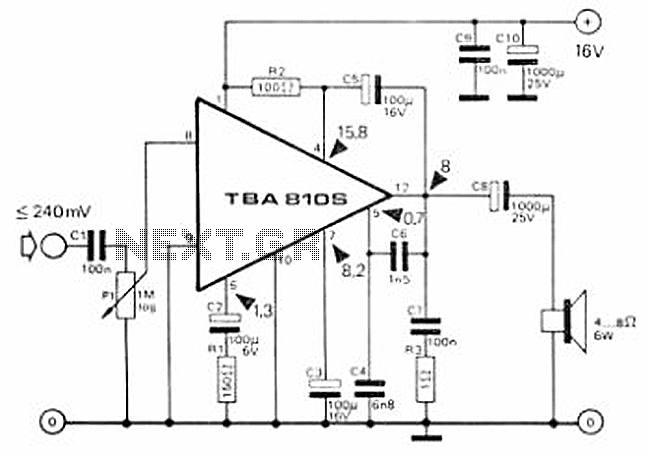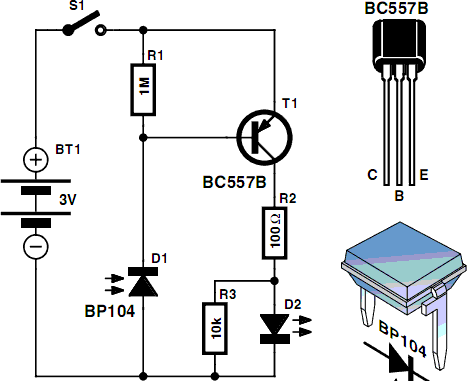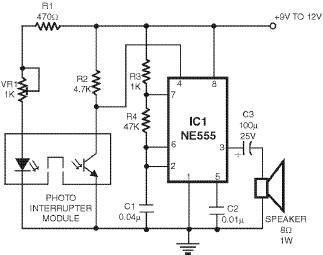
Laser Alarm Circuit

The schematic in question is unconventional in design and should not be used as a model for beginners in electronics. A significant drawback of this basic circuit is that the alarm is triggered only when the light beam on the light-dependent resistor (LDR) is broken. Consequently, if an individual momentarily interrupts the light beam, the alarm will only sound briefly, rendering it ineffective for practical applications. The initial assessment of the schematic identified its failure to provide a reliable alarm system that continues to sound until deactivated or after a predetermined time period. Design criteria were established to ensure the alarm would sound for a duration sufficient to alert nearby individuals, ideally between 30 minutes to 1 hour. This concept, developed with input from peers in the electronics community, aims to enhance the functionality of the circuit. The schematic was created using NI 11 simulation software, and features such as the binary indicators on the output of the 4060 are included for simulation purposes only. Users should refer to the 4060 datasheet for guidance on handling any unused outputs. This circuit can be easily expanded, as it utilizes logic to activate the alarm. For example, it can be modified to include two detection circuits, requiring both to be triggered before the alarm is activated.
The proposed circuit design incorporates a light-dependent resistor (LDR) as the primary sensor, which reacts to changes in light intensity. When the light beam directed at the LDR is interrupted, the circuit triggers a response from a timer circuit integrated with a 4060 binary counter. The timer is configured to keep the alarm active for a predefined duration, which can be adjusted based on user preferences.
The 4060 IC serves multiple functions in this design, including frequency division and timing control. The output from the LDR is processed through an operational amplifier to ensure that the signal is strong enough to trigger the 4060. The timer output can be set to various time intervals, allowing for flexibility in alarm duration.
For enhanced reliability, the circuit can be expanded to include multiple LDRs or other types of sensors, such as passive infrared (PIR) motion detectors. This configuration would require a logical AND gate to ensure that the alarm only activates when all sensors are triggered, reducing the likelihood of false alarms.
The output of the circuit can be connected to various alarm systems, including sirens or notification systems, ensuring that the alert is both audible and visible. Additionally, the design allows for the incorporation of visual indicators, such as LEDs, to provide a visual cue when the alarm is active.
Overall, this schematic provides a foundational approach to designing an effective alarm system that can be customized and expanded to meet specific security needs. The use of simulation software facilitates testing and refinement of the design before physical implementation, ensuring a robust and functional electronic solution.I had a very basic understanding of electronics and how they worked, so when my friend asked me to look at a schematic he found on the net, I jumped at the chance. Now the first thing you should know about this schematic is that it is very unconventional in design.
If you are starting out new, then please don`t follow this poor example of how a sc hematic should be drawn. Now the downside of this simple circuit, if you haven`t already noticed, is that the alarm is only triggered when the light beam on the LDR(photo cell) is broken. For instance if someone is walking by and breaks the beam of light for a split second then the alarm will only sound for a split second.
This is total garbage for any useful purpose. I didn`t exactly fall in love with the above schematic as I had immediately recognized where it failed to provide a real alarm`. One where the alarm would sound until it was turned off or a certain time period had elapsed. So I set out my design criteria 3. Time period for the alarm to sound before a it was shut off. Intruders don`t stay around forever, 30 mins to an 1 hour should be long enough toarousethe neighbors and yet not annoy them for the whole day.
This is my idea(with the help of my friends over at electronicspoint. com forums) of how this type of circuit should be designed to be useful. This schematic was done on NI 11 simulation software and as such things like the binary indicators on the output of the 4060 are there for simulation only(required). Refer to the 4060 datasheet on what to do with any unused outputs. Hope someone finds this circuit useful as it can easily be expanded since it uses logic to drive the alarm.
For instance you could expand the circuit to 2 detection circuits and expand the logic to require that both detection circuits have tripped before the alarm sounds. 🔗 External reference
The proposed circuit design incorporates a light-dependent resistor (LDR) as the primary sensor, which reacts to changes in light intensity. When the light beam directed at the LDR is interrupted, the circuit triggers a response from a timer circuit integrated with a 4060 binary counter. The timer is configured to keep the alarm active for a predefined duration, which can be adjusted based on user preferences.
The 4060 IC serves multiple functions in this design, including frequency division and timing control. The output from the LDR is processed through an operational amplifier to ensure that the signal is strong enough to trigger the 4060. The timer output can be set to various time intervals, allowing for flexibility in alarm duration.
For enhanced reliability, the circuit can be expanded to include multiple LDRs or other types of sensors, such as passive infrared (PIR) motion detectors. This configuration would require a logical AND gate to ensure that the alarm only activates when all sensors are triggered, reducing the likelihood of false alarms.
The output of the circuit can be connected to various alarm systems, including sirens or notification systems, ensuring that the alert is both audible and visible. Additionally, the design allows for the incorporation of visual indicators, such as LEDs, to provide a visual cue when the alarm is active.
Overall, this schematic provides a foundational approach to designing an effective alarm system that can be customized and expanded to meet specific security needs. The use of simulation software facilitates testing and refinement of the design before physical implementation, ensuring a robust and functional electronic solution.I had a very basic understanding of electronics and how they worked, so when my friend asked me to look at a schematic he found on the net, I jumped at the chance. Now the first thing you should know about this schematic is that it is very unconventional in design.
If you are starting out new, then please don`t follow this poor example of how a sc hematic should be drawn. Now the downside of this simple circuit, if you haven`t already noticed, is that the alarm is only triggered when the light beam on the LDR(photo cell) is broken. For instance if someone is walking by and breaks the beam of light for a split second then the alarm will only sound for a split second.
This is total garbage for any useful purpose. I didn`t exactly fall in love with the above schematic as I had immediately recognized where it failed to provide a real alarm`. One where the alarm would sound until it was turned off or a certain time period had elapsed. So I set out my design criteria 3. Time period for the alarm to sound before a it was shut off. Intruders don`t stay around forever, 30 mins to an 1 hour should be long enough toarousethe neighbors and yet not annoy them for the whole day.
This is my idea(with the help of my friends over at electronicspoint. com forums) of how this type of circuit should be designed to be useful. This schematic was done on NI 11 simulation software and as such things like the binary indicators on the output of the 4060 are there for simulation only(required). Refer to the 4060 datasheet on what to do with any unused outputs. Hope someone finds this circuit useful as it can easily be expanded since it uses logic to drive the alarm.
For instance you could expand the circuit to 2 detection circuits and expand the logic to require that both detection circuits have tripped before the alarm sounds. 🔗 External reference
Warning: include(partials/cookie-banner.php): Failed to open stream: Permission denied in /var/www/html/nextgr/view-circuit.php on line 713
Warning: include(): Failed opening 'partials/cookie-banner.php' for inclusion (include_path='.:/usr/share/php') in /var/www/html/nextgr/view-circuit.php on line 713





